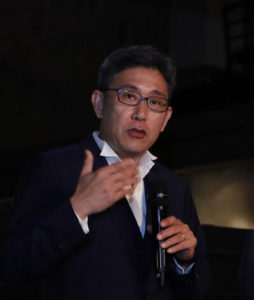
MARK LIU
JERDE / Senior VP and Managing Director
Senior VP and Managing Director of China, JERDE Shareholder, Global Board Director
AIA Founding member, ULI Topical Forum Co-Chair
Mark Liu joined JERDE in 2013 as Sr. VP, Director of Project Management, bringing with him more than 26 years of international design and build experience. Within his role at JERDE he implemented many important initiatives that improved the efficiency and quality of the firm’s services. In September of 2015 Liu was relocated to China to take over a new role as the Managing Director of JERDE’s China office.
Liu has made numerous critical contributions to the company, including building up both the office talent as well as the client base in China, which today has become the firm’s most successful market. He was made full partner in 2018 and has since been elected a Global Board Director. He is also a member of the international organizations, including AIA, TEA, IAAPA, CTBUH, Façade Technology and AmCham.
What advice would you give to future IDA entrants?
I would suggest that start by conducting thorough research on the IDA, understanding its mission, judging criteria, categories, and submission guidelines. Ensure that your presentation is professional and visually appealing, utilizing high-quality images, clear descriptions, and supporting materials that effectively communicate your design concept and process. Craft a compelling narrative around your work, highlighting the inspiration, problem-solving approach, and unique aspects of your designs.
Embrace the competition as a valuable learning opportunity, using the judges’ feedback to improve your skills and grow as a designer. Stay persistent, keep creating, and explore various avenues to showcase your talent. Remember to enjoy the process and be proud of your work, regardless of the outcome.
Enjoy the process, be proud of your work, and continue to strive for excellence in your design journey. Best of luck in your future design endeavors!
Do you see design an expression of art?
Design can certainly be seen as an expression of art, as it involves creative thinking, aesthetic considerations, and the intention to communicate and evoke emotions. Like art, design has the ability to convey messages, provoke thought, and inspire individuals.
Designers often strive to create visually appealing and innovative solutions that go beyond mere functionality. They carefully select colors, shapes, textures, and compositions to create harmonious and impactful designs. Moreover, design can challenge conventions, break boundaries, and push the limits of creativity, much like art. Design balances aesthetics with functionality, considering practicality, usability, and the context in which it exists.
Ultimately, the relationship between design and art is complex and multifaceted, with overlapping elements and distinct differences, but it is undeniable that design can be a powerful and expressive form of artistic creation.
How do you feel design has evolved over the past years and how do you see it evolving in the future?
Design has evolved significantly in recent years, driven by technology, changing user expectations, and a growing focus on sustainability and ethics. User-centered design and digital platforms have gained prominence, while the future holds potential for personalized and immersive experiences. Integration of design thinking and a focus on inclusive design will shape the evolving landscape. Ultimately, design will continue to play a crucial role in improving human experiences and shaping a better future.
What do you think are the biggest challenges and opportunities for a designer today?
One of the major challenges is the rapid pace of technological advancements. Designers need to stay updated with emerging tools, software, and platforms to remain competitive and deliver cutting-edge solutions.
Additionally, the increasing demand for sustainability and ethical design presents a challenge and an opportunity for designers to integrate environmentally friendly practices into their work.
On the other hand, there are immense opportunities for designers to make a positive impact. The growing emphasis on user-centered design opens doors for designers to create meaningful experiences that address user needs and preferences.
Designers also have the chance to leverage emerging technologies like artificial intelligence, virtual reality, and augmented reality to create immersive and transformative experiences. By embracing these challenges and seizing opportunities, designers can shape the future of their field and contribute to positive change in society.
Is there anything in particular that you look for when judging a design award?
I look for designs that exhibit a strong concept, thoughtful problem-solving, and a clear understanding of the target audience. Meanwhile, recognize designs that demonstrate excellence, creativity, and a positive contribution to the field.
If you were to offer advice to a designer on the keys to succeed in the industry today what would you tell them?
I would emphasize the importance of a growth mindset and continuous learning.
The design industry is constantly evolving, and staying up-to-date with emerging trends, technologies, and methodologies is essential. Embrace a curiosity-driven approach, actively seek out new knowledge and skills, and be open to experimenting and taking risks.
Collaborate with peers, mentors, and professionals in the field to gain diverse perspectives and insights. Cultivate a strong work ethic, attention to detail, and a commitment to delivering high-quality work.
Develop excellent communication skills to effectively convey your design ideas and build strong relationships with clients, colleagues, and stakeholders.
By combining talent, adaptability, continuous learning, and a strong professional network, designers can position themselves for success in the dynamic and competitive design industry.